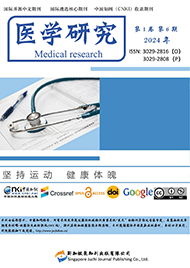
 info@juzhikan.asia
info@juzhikan.asia
 info@juzhikan.asia
info@juzhikan.asia
卒中后痉挛相关生物标志物的研究进展
区家源一作 朱美英一作 张建博二作 苏浩强三作 吕政通讯作者
广东省深圳市龙岗中心医院,518000;
摘要:卒中后痉挛(PSS)作为脑卒中后常见的并发症,其确切定义及机制至今尚未充分揭示,同时也因动物实验研究的匮乏,PSS相关生物标志物的确立面临重大挑战。因此,探讨PSS相关生物标志物,在寻找有效治疗PSS的途径上具有极其重要的作用。本综述旨在从GABA-Glu能系统、氯离子稳态以及BDNF-TrkB方面入手,深入探讨PSS的相关生物标志物,通过揭示其相关性,尝试整理其在PSS研究中的作用,为研究PSS提供参考。
关键字:卒中后痉挛;GABA;Glu;氯离子稳态;BDNF-TrkB;KCC2
参考文献
[1]Wissel J,Manack A, Brainin M. Toward an epidemiology of poststroke spasticity[J]. Neurology, 2013,80(3 Suppl2):S13-S19.
[2]陈楠,华艳,白玉龙.卒中后痉挛状态发生机制的研究进展[J].中国康复理论与实践,2021,27(5):588-594.
[3]Sears S M, Hewett S J. Influence of glutamate and GABA transport on brain excitatory/inhibitory balance[J]. Exp Biol Med (Maywood), 2021,246(9):1069-1083.
[4]李静雯冯晓东胡延超李瑞青郝文雪.γ-氨基丁酸能系统在脑卒中后痉挛状态中的研究进展[J].中国老年学杂志,2023(43(04):994-997.).
[5]Han X,Guo F, Chen L, et al. The Effects of GABAergic System under Cerebral Ischemia: Spotlight on Cognitive Function[J]. Journal of neural transplantation & plasticity,2020,2020(2020):1-9.
[6]Shahsavar A, Wellendorph P.GABA transport cycle:beyond a GAT feeling[J].Nat Struct Mol Biol,2023,30(7):863-865.
[7]Wang J,Fidimanantsoa O L,Ma L.New insights into acupuncture techniques for poststroke spasticity[J].Frontiers in public health,2023,11:1155372.
[8]Duy P Q, He M, He Z, et al.Preclinical insights into therapeutic targeting of KCC2 for disorders of neuronal hyperexcitability[J].Expert opinion on therapeutic targets,2020,24(7):629-637.
[9]Tillman L,Zhang J. Crossing the Chloride Channel:The Current and Potential Therapeutic Va
lue of the Neuronal K(+)-Cl(-) Cotransporter KCC2[J].Biomed Res Int, 2019,2019:8941046.
[10]Cote M,Gandhi S, Zambrotta M, et al. Exercise modulates chloride homeostasis after spinal cord injury[J].J Neurosci, 2014,34(27):8976-8987.
[11]Xie L, Xie Y, Mao G, et al. Decreased spasticity of Baishaoluoshi Decoction through the BDNF/TrKB-KCC2 pathway on poststroke spasticity rats[J]. Neuroreport, 2021,32(14):1183.
[12]Awad P N, Amegandjin C A, Szczurkowska J, et al. KCC2 Regulates Dendritic Spine Formation in a Brain-Region Specific and BDNF Dependent Manner[J]. Cerebral cortex (New York, N.Y. 1991), 2018,28(11):4049-4062.
[13]Beverungen H, Klaszky S C, Klaszky M, et al. Rehabilitation Decreases Spasticity by Restoring Chloride Homeostasis through the Brain-Derived Neurotrophic Factor-KCC2 Pathway after Spinal Cord Injury[J]. J Neurotrauma,2020,37(6):846-859.
[14]Lee-Hotta S, Uchiyama Y, Kametaka S. Role of the BDNF-TrkB pathway in KCC2 regulation and rehabilitation following neuronal injury: A mini review[J]. Neurochem Int,2019,128:32-38.
[15]Karantali E, Kazis D, Papavasileiou V, et al. Serum BDNF Levels in Acute Stroke: A Systematic Review and Meta-Analysis[J]. Medicina (Kaunas, Lithuania),2021,57(3):297.
[16]Zhou X,Deng X, Liu M, et al.Intranasal delivery of BDNF-loaded small extracellular vesicles for cerebral ischemia therapy[J].J Control Release, 2023,357:1-19.
[17]Bilchak J N, Caron G, Cote M. Exercise-Induced Plasticity in Signaling Pathways Involved in Motor Recovery after Spinal Cord Injury[J].Int J Mol Sci,2021,22(9).
[18]Ziemlinska E, Kugler S, Schachner M, et al. Overexpression of BDNF increases excitability of the lumbar spinal network and leads to robust early locomotor recovery in completely spinalized rats[J].PLoS One,2014,9(2):e88833.